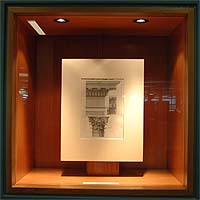Windows into architectural ruins
| The vitrines are situated in the Charles Brasch Court and provide a lively accompanyment to the treasures displayed in the de Beer Gallery. |
The Temple of Vesta at Tivoli', from Antoine Desgodets, Rome in its ancient grandeur. John Weale, London, 1851.
This engraving is from the measured drawing by Antoine Desgodets (1653-1728)
of the Temple of Vesta at Tivoli. It records the placement of the surviving
columns of the dramatically sited structure above the river at Tivoli
near Rome. In his early twenties, Desgodets traveled to Rome where he
carefully and systematically measured, described and drew existing ruins.
Each work was measured several times. His practice set the standard to
be emulated for over a century to follow. This temple from the 1st century
B.C., was illustrated by such artists as Claude Lorrain and Piranesi.
It was a favourite of Soane, who took it as a design source for his exterior
columns on the Bank of England.
Three Columns in the Campo Vaccino' from Antoine Desgodets, Rome in its ancient grandeur. John Weale, London, 1851.
This capital is from one of three remaining columns of the so-called the Temple of Jupiter Stator (Temple of Castor and Pollux) in the Forum in Rome. Its composition was highly regarded in the18th century. The architect, George Dance, identified it as 'the finest example of Corinthian order perhaps in the whole world'.
Henry Parke, Royal Academy lecture drawing showing a student on a ladder, with a rod, measuring the Corinthian order of the Temple of Jupiter Strator, Rome, SM 23/9/3, Reproduced with Permission of the Trustrees of the Soane Museum, London.
This is a drawing of a gentleman on the Grand Tour who is about to take measurements of the column detail. It was used by John Soane in his discussion of the Corinthian order in a lecture at the Royal Academy. Presumably the graphical outcome would be similar to that of Desgodets shown alongside. Soane had purchased a copy of the capital which he encouraged students to measure and draw. He repeated the order in his own design for offices at Whitehall.
Joseph Gandy (1771-1843), Aerial cutaway view of the Bank of England from the South East, 1830. From John Soane architect: Master of space and light, London, Royal Academy, 1999.
Joseph Gandy's magnificent illustration of John Soane's design for the Bank of England ambiguously draws upon the drawing convention of the aerial cutaway and the 18th century tradition of the illustration of ruins. In doing so it presents the Bank as part of a long tradition of former grand imperial monuments dating back to classical Greece and Rome.
Visit other ruins exhibitions
In Ruins: Artists and Ruins from the Baroque to the Blitz
Piranesi and Architectural Fantasy
|
|
|
| Three Columns in the Campo Vaccino' from Antoine Desgodets, Rome in its ancient grandeur. John Weale, London, 1851. | |
